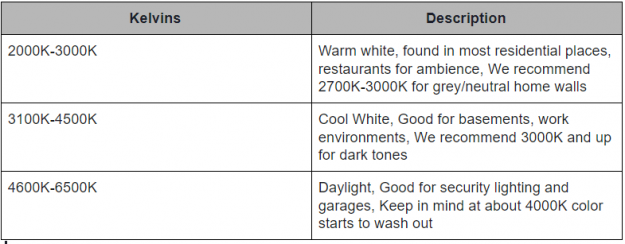Lumens, Watts, and Kelvin | Watts the Difference Between These Basic Lighting Terminologies?
Jul 26, 2021, 3:49 PM

Photo: Adobe Stock
 This article about lumens, watts, and kelvin is sponsored by Lighting Design.
This article about lumens, watts, and kelvin is sponsored by Lighting Design.
Lighting terminology is really easy to get lost in. If you don’t understand the difference between lumens, watts, and kelvin, you aren’t alone. Here’s everything you need to know the next time you are buying lights for a room.
Kelvin

Photo: Adobe Stock
Kelvin is a light’s color temperature. “Lights have a temperature?” you might be asking yourself. Yes, they do! Imagine yourself in a room with incandescent bulbs. The lights themselves make the room appear warmer. While if you were to plug in what is commonly referred to as a daylight bulb, you’d have a much bluer color. The blue makes the room feel colder. All this is important because it can determine the aesthetic of your design space. And knowing where to place these lights in a space to balance the color temperature can be incredibly important too.
Here is a chart that will help you when you are picking out the correct color temperature for your space.

Photo: Lighting Design
Beware though! More than one color temperature can make a space look potentially cheap. That’s because it will look like you just ran to the store and grabbed the first bulbs you could when one burned out. Pick one color temperature per room, or even house, and stick to it. Unless of course, you have color-changing bulbs…
Lumens and Watts

Photo: Adobe Stock
Lumens and watts can be categorized together because they are closely associated. The amount of watts your light bulb has is directly proportional to how much light your bulb will emit. The amount of light emitted is your lumens for that bulb. Check out the chart to help you figure out how much light you will get per the amount of wattage.

Photo: Lighting Design
The chart includes both incandescent and LED light bulbs. LED light bulbs actually take a lot less wattage to get the same amount of light. If you want a light to be brighter, but you’re worried about maxing out the wattage, switching to an LED bulb is absolutely the way to go!

Photo: Adobe Stock
Let’s say you have a 60-watt fixture, with a 60-watt bulb. If you don’t like the amount of light you are getting out of the bulb, try switching for a 12-17 watt LED bulb. This range is typically about the same as a 75 W incandescent bulb. But because LEDs use less wattage, you can still use the 12-17 watt LED bulb in a 60 W fixture. More light, less energy!
Related articles:
- Spring Cleaning Means it’s Time to Clean Your Lighting Fixtures | How to Clean Lampshades, Lights, and Lighting Fixtures in Your House
- Lighting Ideas: What You Need to Do To Add Beautiful and Inspired Lighting Fixtures to Your Home
- How You Can Easily Upgrade your Home with Great Looking Outdoor Lighting Fixtures







